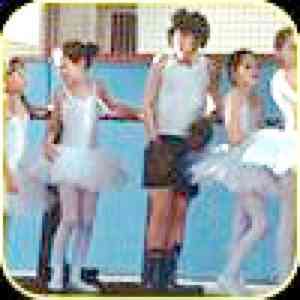
Figure 1.--Billy Elliot comes from a coal mining family. He by happenstance is exposed to ballet--and to his surprise is enthralled by it. His father is agast.


Figure 1.--Billy Elliot comes from a coal mining family. He by happenstance is exposed to ballet--and to his surprise is enthralled by it. His father is agast. |
This British ballet film won the audience award at the 2000 Edinburgh Film Festival. It is a touching drama about a boy with dreams of becoming a ballet dancer, a dream that his family and friends can not share and fight offensive and threatening. Billy is an 11-year-old boy who wants to be a ballet dancer against the background of the mid-1980's miners'
An well selected cast delivering a believable performance coupled with an intelligent script by Lee Hall and deft direction by Stephen Daldry make for an excellent film. Lee Hall has produced a compelling, multi-faceted script. He attempts to address the story behind the coal strike--arguably a turning point in modern British history. He also touches on expression through art while just telling a good story. This is thanks in large part to Stephen Daldry's light touch as director, plus a great soundtrack which includes T. Rex, The Jam and The Clash.
The British (both English and Scottish) film industry seems to delight in these films where uncultured working class boys are given opportunities to expand their cultural horizons or attend good schools. The emphasis is how Britain's class system has made it difficult for working class boys to suceed. In the films this is usually because the elite refuse to accept them. In this film, it is Billy's own family that is the obstacle.
The film is set in a gritty English coal mine town during the 19??s. It makes no attempt to explore the social and political issues surrounding the backdrop of the coal strike. British films use to dwell on Welsh coal miners (How Green is My Valley). Of late film makers have focused on the country's purported north/south divide. One reviewr sees Billy Elliot as a new folm "sub-genre," the depressed Northern town feel-good story. A reviewr writes, "The impression I get is that you can hardly move in the North of England these days without bumping into frustrated singers, dancers, actors or trombonists".
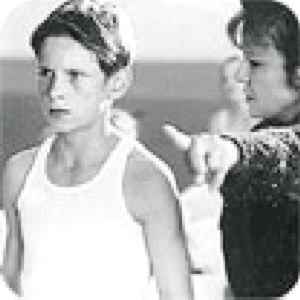
Figure 2.--I think this is where the dancing teacher tells Billy that if he is going to participate in the ballet lessons, all the other dancers were girls, that he has to take off his boots and wear dancing shoes. |
While Billy Elliot is in many ways an excellent film, especially its depection of Billy and his famoly. The film, however, is also a good example of the penchant for movie makers to rewrite history to conform with their ideological or natiinal attitudes. The British have eperienced in 2000 some examples of this with a big-budget Hollywood film giving the Americans credit for seizing an enigma (German coding machine). It was of course the Royal Navy that accomplishhed this when in 1941 they managed to get one from a German wheather boat in the Noth Sea. (The American Navy also seized one, from a U-boat forced to the surface, but much later in the War.
Billy Elliot takes the side of the miners. It presents the miners as nobel, if uncultured, and solodly united to persue their interests. It shocases the film's view of the Government's (headed by Margaret Thatcher) brutal use of the police. History of course is composed of a compsite of the collective experience of millions. Left unsead by the film was that the labor unions by the 1980s had brought Britain to a standstill and dominated the Labour Party which it used to promote union interests. Many historians might date Britain's modern Renaisance with Thatcher's stand against the unions, especially Miner;s Union head Arthur Scargill.
The central performances from Julie Walters as Billyís teacher, Gary Lewis as his father and especially Jamie Bell as Billy really could not be improved upon.
Jamie Bell, The actor playing Billy, described his experience with dancing: "He has to give some keys back to the teacher, to Mrs Wilkinson, so he gives her the keys and she's not interested, so he's watching them (ballet dancers) and she kind of rocks his elbow a bit saying "Do you want to try it?" He says no I'm fine but eventually she
pushes him so much he eventually starts wearing ballet shoes.
In the North East there's not much opportunity for young up and
coming North East actors. So I felt a bit like Billy who feels if he
doesn't do something to change his life forever he end up down the
pit like his father and brother. So in a way I felt, I thought to myself that I was going to have to do something that's going to lift myself out of here. There was this time I got dragged to a competition and there was this girl dancing and the music; I really like music,
because I'm into Jazz and all that stuff; I could hear the music and it
was obvious that she should be dancing in time to the rhythm of the
music, and she wasn't doing it, she was missing beats all over the
place. And I said that's not right, I could hear it, and I was thinking to myself, that's not right. So I said to my mam, I can do better than
that, and she said, right I'll get you some tap shoes you can start on
Saturday. When it first got out that I was dancing, the lads at school
were, `Oh you shouldn't be doing that Jamie, it's not right, it's for girls. You should be doing football or hanging around with us not going to dance classes." With Billy it's more violent I think. His dad does take it out on him, he pushes him against a door and stuff. He doesn't like it at all. When I was dancing, I was like I need a bit more, I need to give them something what they want so that they'll applaud me at the end. While Billy did it for himself, he kept it inside."
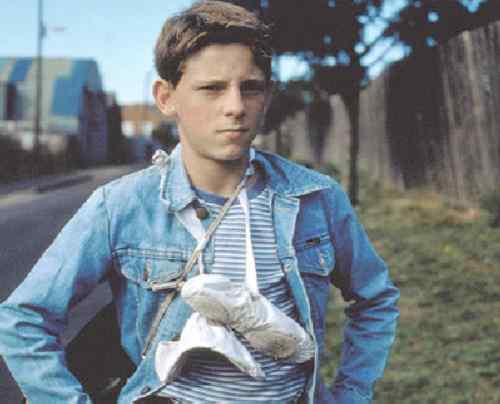
Figure 3.--Billy is seen here going to ballet practice with his dancing shoes. This would have been a bit of a problem in a rough neighborhood. |
Some reviwers criticize the opening of the film. Trouble is brewing in the coal mines. The miners go out on the picket lines and the police begin to get serious. Is it reasonable to think, asks one viewer, "... that a young boyís thoughts naturally turn to tippy toes, tights and tu-tus. At any rate in the film Billyís do."
Proud of his fancy footwork in the boxing ring at the local village hall, young Billy's eye is caught by the unscheduled invasion of Mrs.
Wilkinson's ballet school. Her usual classroom has been taken over
as soup kitchen for striking miners. At the end of his boxing lesson
George (the coach), orders Billy to stay behind to hand over the keys
to the local ballet teacher, Mrs. Wilkinson. As Billy weaves his way through the throng of ballerinas, he becomes lost in their movements. Debbie, one of the young ballerinas, challenges Billy to try out the exercises and not to back
down; he tags on to the back of the class, surprising the somewhat
jaded teacher. Pulling him aside, Mrs. Wilkinson (who happens to be
Debbie's mother) tells Billy to replace his boots with a pair of ballet
shoes if he's to join in.
Billy's father thinks that his son is down at the local town hall taking boxing lessons, but one evening right, just for a laugh, Billy joins the ballet class thatís been forced to share the gym because the miners are using the ballet classroom as a soup kitchen. Billy soon fines that he is a naturally gifted dancer. His teacher wants Billy to audition for, of all things, the Royal Ballet School.
Predictably bIlly's father and brother donít want what they see as a cissy in the family. They refuse to have anything to do with it when they find out anout Billy's ballet. This leaves poor Billy trying to cope with frustrated ambition, a best friend who has troubles of his own (a sub-plot not really needed in the film), and a girl who has taken fancy to him.
On Christmas night Billy's friend wabts to dance with him. It is an important scene becaue as they were dancing, Billy's father appeared at the gym a little drunk and ordered him to go home. Instead of doing that, billy started dancing in front of his father. It was his own way to say that he loved dancing and that he doesn't matter what other's could think about it.
Billy was finally admitted to the National School of Ballet in London and he becomes a
star. The last scene of this movie showing an older Billy in the lead male role, the father comes to the theatre to see him.
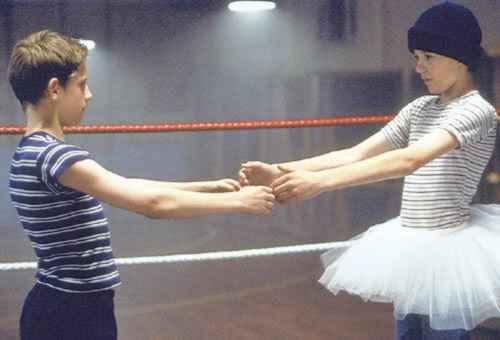
Figure 4.--Billy is seen here with his best friend from their working class neigborhood. Here Billy's friend wears a tutu. Their relationship and the boy's costumung is a distracting and unecessary sub-plot. |
The main character is Billy Elliot introduces us to the title character, an 11-year-old boy who wants to be a ballet dancer against
the background of the mid-1980's miners' strike. Both his father
and brother are on strike, and his ambitions seem both trivial and effeminate to his family. But encouraged by his tutor, Billy finds first escape, then rebellion in his dance. And as the reality of defeat in the strike sets in, the entire community finds itself behind Billy. Billy is transformed from quiet loser to passionate rebel.
One reviewer describes Billy Elliot as a "treat". He describes it as, "A film that leaves you with a big smile and a broken heart, wanting it to watch it all over again." This reviewer describes Billy Elliot as "honest film", which he says captures "both joy and tragedy--counter-pointing exhilerating
scenes of Billy's dance with brutal scenes from the strike". [Ferret, 1999] HBC rather agrees that in many ways the film is honest in its depictions of how Billy and his family may reacted. (In fact, however, this varies from the actual dancer the film is based upon. The film, however, is less than honest in the depictions of state brutality. First, it is first unclear how honest or representative those depictions are. Second acts of violence and illegal activities are ignored. Thirs, left unsaid is what a modern state should do when a small group like coal miners (or other labor union or corporation) has the ability to disrupt the like of the entire nation.
The British papers included massive reviews of Billy Elliot. One was from the same people who made Four Weddings and a
Funeral. The reviewer reckons it'll go down as one of the best
British films of all time--HBC believes this is a bit of a streach. Another reviewer said it would be there among the all-time great classic weepies! (Films that reduce you to tears.)
This is an excellent picture. It has an excellent chance of winning an oscar, probably for the best foreign film.
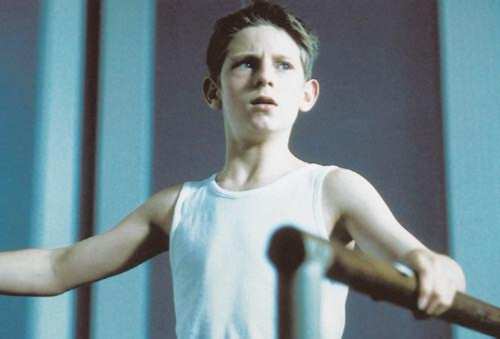
Figure 5.--Billy is at first surprised with his new fouund passion for ballet. |
Here are some quotes from British reviewers:
THE HARTLEPOOL MAIL....(It's) a moving, simple, funny tale,
which had its preview audience moved to tears - and it was made on
home ground. The follow up to "The Full Monty?" I don't think so -
Billy Elliot is a thousand times better.
EMPIRE. ...Billy Elliot is not only the best British film of the year, but one of the best films of the year, a scintillating debut from both
Daldry and Bell which will stay with you long after the closing credits
have rolled. Do not miss. Five stars.
THE SPECTATOR . ....heart warming and magnificent film debut.
FILM REVIEW .... A poignant analysis of masculinity threatened, of
social pressure of the worst kind, of the choice between playing it
safe and risking everything for a leap into the unknown, Billy Elliot is a film that puts bigger, brasher movies to shame. In all sorts of ways it is simply perfect.
DAILY MAIL . ...I caught the film - again- in Edinburgh and still found
it funny and emotionally devastating. Daldry and his cast of Jamie
Bell, Gary Lewis, Julie Walters and Jamie Draven, have created one
of the years best films which will capture hearts and minds on a
global scale.
The film was not theatrically relased in Britain until September 29, 2000. It resulted in extensive press coverage, most of it quite favorable. Some of the most hard-bitten film critics here have taken
whole pages in mass circulation newspapers to rave about what a
brilliant film it is and how they practically cried from beginning to
end. Some have predicted that it will have a major impact on many boys, possibly leading to a surge in demand for places at dance schools.
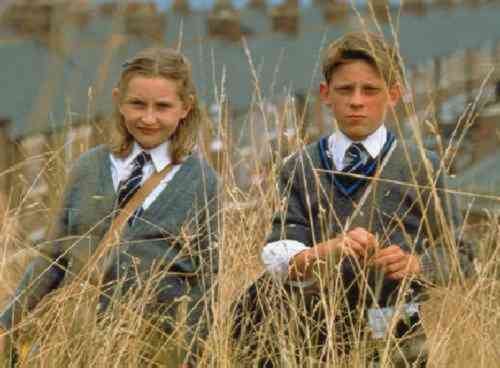
Figure 6.--Billy is seen here in his school uniform with one of his friends from the ballet classes. |
The film is based on the true story of a member of the Royal Ballet who comes from a mining community and is now aged 34; the only difference is that in the film, Billy's dad is appalled, whereas the real-life character's parents were in fact very supportive. The timing placing the events in the context of the 1984 coal strike is a dramatic device not based on the actual experiences.
I have not seen the film yet, so am unsure just what clothes are worn in the film. Available still provide some information.
Billy wears a common English school uniform. He wears a basic grey sweater, white shirt, and stripped tie. This uniform, without a blazer, has been adopted by many primary schools.
Billy at least at the beginning of the film wears boxing gear. This includes a protective helmet, a singlet, shorts, white socks, and boots.
Billy usually wear regular clothes, that consits in blue jean, t-shirt with stripes and black (worker style) boots, also a blue jean jacket. Besides his school uniform , Billy wearing a blue suit with a white shirt, blue tie, white socks and black shoes (he used
this suit when he went to perform to the England ballet academy). Also on this movie, you see billy wearing a PE uniform wich consisted in short, t-shirt, socks and sport shoes all white. Billy's friend wears the same regular clothes and school uniform that billy but he also wears a stocking cap (watch cap). He wears that "cap" in almost all his scenes in the film.
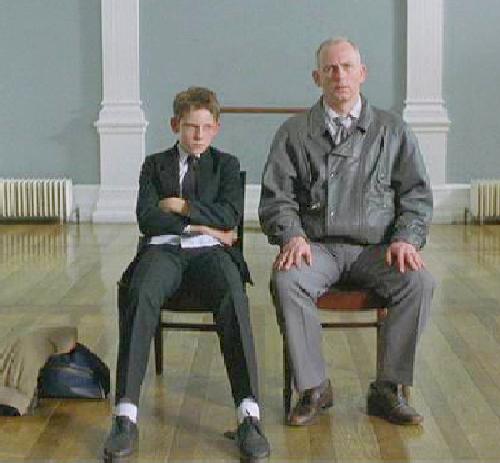
Figure 7.--Billy is seen here with his father in a ballet studio. |
I'm not sure what Billy wears to practice or for his performances. I do know he wears white ballet shoes, in one image arond his neck walking to dancing practice. Its probably a good thing he had boxing lessons if he did that in a tough neighborhood.
England is not one of the countries that one thinks aboutbin connection with ballet, but there are several schools which provide ballet training in England. Many are classical schools with very struict rules about practice costumes. Schools in the United Kingdom have a variety of dance programs. Many primary schools have dance programs for the younger children. Once it becomes optional, usually only the girls want to participate. This is
particularly true of ballet. Most school programs are entirely are largely for
the girls. Ballet is mostly pursued at private dance schools aftr regular school. There is at least one seconady school, the Arts Educational School which has a program that dooes attract boys.
While this is a beautiful, well made film, we take issue with one aspect of it. One of the boys, Billy' best friend is pictured as gay. We see no reason for doing this and is hardly needed for the basic storyline. It tends to perpetuate the sterotype that boys who do ballet or gay. Even worse, however, is costuming him in a tutu and also a green dress. here certainly are gay boys wo do bllet, just as there are gay boys who do football, play chess, and participate in choir and band. Having this boy wear garments that boysdoing ballet do not wear we believe is both gratuitous and pandeing to sterotypes not founded in relaity.
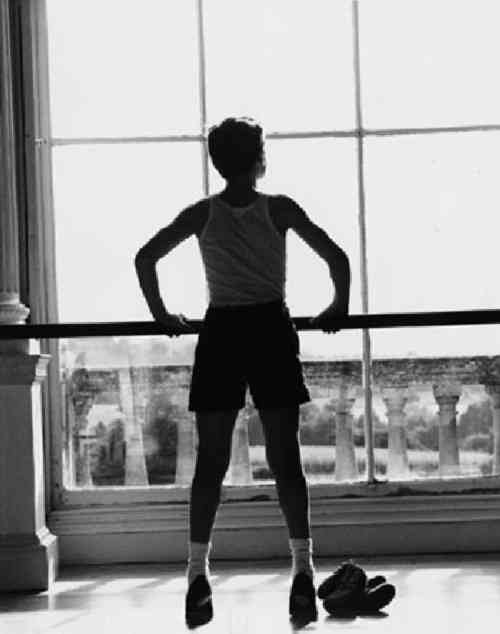
Figure 8.--Billy is seen here at the Royal Academy. |
An Australian reader reports, "'Billy Elliot was a gem of a movie. Julie Walters was spot on as the ballet teacher, but I do not think the director used her charactor enough in the film. I think which is a crying shame. The other boy in the film was not a bad choice'as a friend. At least they did not sweep this sensitive issue under the
carpet. The boy was just a caring little soul who was being a comrad in ballet ability and probable future students together over the many years ahead in other words he was comforting Billy like a younger brother would do and the boy would have gone through pain of trying to gain entry into the school and feeling scared or let down about blowing his chances just like Billy was currently doing. At least he backed his mate up concerning ballet dancing. If he had been a bully then I think Billy might have been put off by him. Billy was born with the gift. The clothing Billy wore was quite the same as I wore but at a much later age. I had those soccer type green shorts in the opening of the film but mine were red because I liked Liverpool and his ballet shorts were what I wore to ballet aged 7 on hot days. Ok. The miners might of had the whole hog concerning the coal striking but they did show the thuggery kept up and over the top by the older brother Tony. So I think the coalminers were villians as well as victims because of the horrible conditions they worked under. But Billy and Jamie Bell were wonderful and I enjoyed the ride along with him through boxing lessons, ballet, thuggery in the streets, coping with a gay friend, and handing it in a mature manner, not going great guns concerning ballet lessons, sneaking about and hiding the fact that he was doing ballet secretly and behind his
dad's back and the really sad moments when he missed his dear mum. The ending was fantastic with the grown up Billy Elliot making his entrance on stage doing 'Swan Lake'. I was a bit incredulous that 'The Lake In The Moonlight' was not used on the cd soundtrack as this one
of Tchakovsky's better works. The test at the Royal Ballet School was well done."
A HBC reader gives us a glimse of the miners strike referred to in the film. "I worked in a Primary schoool then in a mining community. The miner's strike was in full swing and a
very bitter affair. The pupils parents were mainly miners. It was a hot sunny thursday afternoon so I decided that it was a good time to go on a historical walk along the Bridgewater canal. The boss gave his permission and so off we set after lunch. A crocodile
line of of 24 9 year old pupil in twos walked along the road. It was being led by me and a classroom assistant. We turned a corner and walked right into a confrigation of miners. A Bus containing 'scab workers' had gone through the picket line. It looked very ugle and there were policemen trying to hold back the angry men. Our arrival was spotted. The cry went up 'Look out teacher and his kids are coming hold off. The wall of strikers parted. silence ensued. we passed by. Some of the kids recognised their dad's. 'Hi dad!' 'See you
tonight dad.' The father's gave a cheery wave and we exchanged pleasantries. As we got well away. It was back to picketing and a return to the uproar." [Ferguson]
Ferguson, William. E-mail message, March 11, 2003.
Navigate the Boys' Historical Clothing Web Site:
[Return to the Main English movie page]
[Return to the Main ballet movie page]
[Return to the Main alphabetical "BF-BL" movie page]
[Introduction]
[Activities]
[Biographies]
[Chronology]
[Clothing styles]
[Countries]
[Bibliographies]
[Contributions]
[FAQs]
[Glossaries]
[Satellites]
[Tools]
[Boys' Clothing Home]
